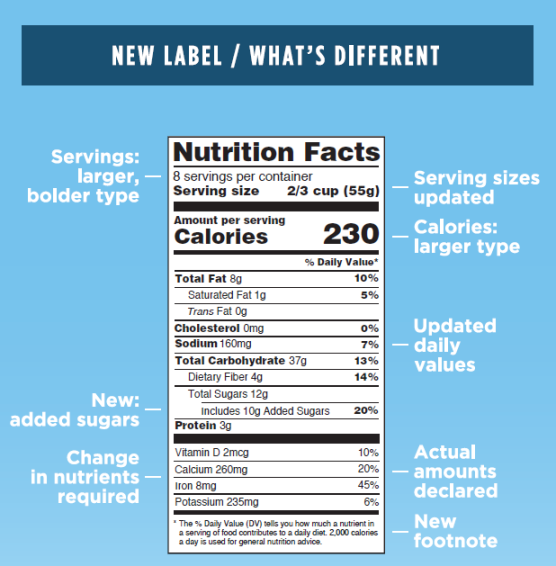It was announced on May 20th that the FDA has approved several changes to the traditional nutrition labels on food packaging, aimed at facilitating informed consumer choices. These updates, which are a part of Michelle Obama’s Let’s Move! campaign to combat childhood obesity, are the first revision to the labels since they were introduced twenty years ago. Therefore the new labels, which companies must implement within the next two years, will reflect modern scientific knowledge and nutritional needs. Here are the main differences to look out for and how they’re intended to change your food consumption.

Photo courtesy of fda.org
1. Emphasis on calories and servings
Part of the refreshed design the presentation of calories, servings per container, and serving size in larger, bold font. Making these values more in your face should help us to be more aware of our calorie intake and make smarter food purchases. Also, the calories from fat value was deemed unnecessary and will be removed due to more up to date nutrition information showing that total calories and type of fat are more relevant to health than the amount of fat.
2. Added sugars

Photo courtesy of http://tobyamidornutrition.com
Including added sugars under the total sugars value is also due to the latest scientific research, which shows that it’s hard to get enough nutrients while staying within your daily caloric limit if more than 10% of those calories come from added sugar. This addition also corresponds with the 2015-2020 Dietary Guidelines for Americans which encourage reducing added sugar consumption.

Photo courtesy of giphy.com
3. Realistic serving sizes

Photo by Julia Benson
On the old labels serving sizes proposed what portions people should be eating ideally. The new labels will instead present serving sizes that accurately reflect how much people actually tend to eat. For example, a 20oz soda might be more than one serving in an ideal world, but most people are going to drink the whole bottle. The new label will present the bottle as one serving so that it’s more obvious what we’re actually taking in.
Also honestly, who actually eats just a half a cup of ice cream at a time? A pint of ice cream will now, more realistically, be considered only three servings. Some products will also have “dual column” labels to show both ‘per serving’ and ‘per package’ values, for those of us who consider a pint of ice cream or a box of mac and cheese to be just one serving.
4. Vitamins and minerals revamped

Photo courtesy of annietarasova
The vitamin section of the label will also be adjusted to reflect modern nutrition info and needs. Recent studies stress the importance of potassium and Vitamin D, so those values will now be required. On the other hand, people today are much less likely to be Vitamin A or Vitamin C deficient than they were 20 years ago, so those values are now optional. The FDA will also require companies to include the actual amount, not just the percentage of each vitamin, to increase clarity for the consumer.
These updates clearly don’t force you to consciously change anything about your eating habits. In general they really just aim to include new nutritional discoveries and needs, increase transparency, and more accurately illustrate modern eating habits. So if these new labels do their job right, we should be making healthier, more informed food choices without even trying.


